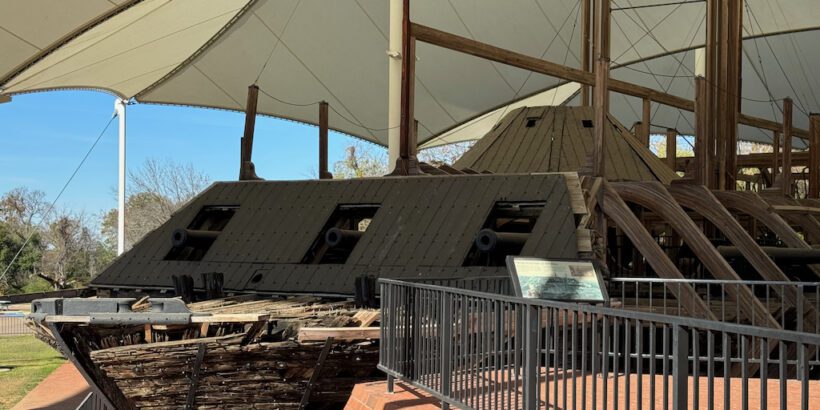Civil War History is one of my new fascinations. Out of all of the recent wars that I’ve been studying, the Revolutionary War, the French Indian War, and the War of 1812, it is the American Civil War that really makes my head spin.
There are a number of fascinating battlefields to check out across the country and of course many different museums to see.
But one of the most fascinating objects from the Civil War that you can check out has to be the USS Cairo.
What is the USS Cairo?
The USS Cairo stands as a historic ironclad gunboat that saw action during the Civil War. Launched in 1862, it met its demise in the same year when it fell victim to a manually detonated mine.
Submerged in the Yazoo River until its recovery in the 1960s, the Cairo now holds the distinction of being “the only remaining ironclad of its type in existence.”
Currently preserved and showcased at the Vicksburg National Military Park, the USS Cairo provides visitors with a distinctive window into the naval history of the Civil War era.
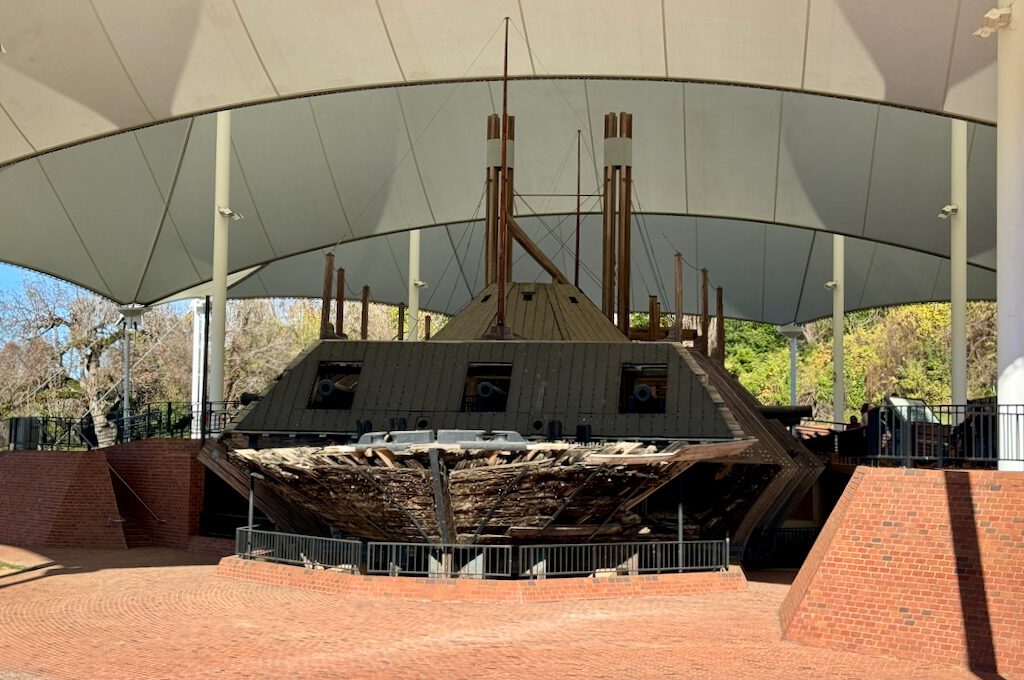
USS Cairo brief history
The USS Cairo, one of seven shallow-draft City Class river ironclads, was commissioned in January 1862, spearheading an era of naval innovation.
Despite its relatively brief tenure, the Cairo participated in a few notable engagements, including the Battle of Fort Pillow (or Plum Point) and one in Memphis, Tennessee in June 1862.
But on the crisp morning of December 12, 1862, Lieutenant Commander Thomas O. Selfridge, Jr., at the helm of the Cairo, led a flotilla of gunboats through the treacherous waters of the Yazoo River.
His mission: to dismantle Confederate batteries and clear the river of lurking mines.

Navigating the narrow and murky river, the gunboat came under enemy fire approximately 7 miles north of Vicksburg. As Selfridge ordered the guns into readiness and commanded the vessel to surge forward at full steam, the USS Cairo was suddenly jolted by the concussions of two rapid explosions.
The initial blast ripped a substantial breach into the port side bow of the wooden hull—a vivid testament that visitors can still observe today. The subsequent explosion occurred moments later, targeting the armored belt amidships on the starboard side. Interestingly, this marked the first instance of a ship succumbing to a mine remotely detonated by hand.
The resulting holes were a disaster for the ship, causing it to sink in just 12 minutes and drop to the riverbed about 36 feet down. Thankfully, no one lost their life in the mishap.
Over the years, the vessel faded from collective memory, gradually obscured by layers of silt and mud deposited by the river’s currents.
This inadvertent shrouding, acted like a natural cocoon, and inadvertently safeguarded the USS Cairo. Consequently, it metamorphosed into a maritime time capsule, its interior artifacts remarkably well-preserved within an oxygen-deprived environment.
Determining the precise location of the ship became a speculative puzzle over time.
As crew members passed away and local knowledge waned, the whereabouts of the Cairo remained elusive, obscured by the passage of years and the mysteries of the river.
While speculation surrounded the location of the USS Cairo for years, it wasn’t until the 1950s that a historian at Vicksburg National Military Park, Edwin C. Bearss, managed to roughly pinpoint its resting place.
Armed with nothing more than a pocket compass and probes, the historian and his two companions embarked on a quest to locate the ship. By 1956, their confidence grew, and they believed they had indeed discovered the Cairo. However, the murky depths, laden with heavy mud and swift currents, posed formidable challenges for divers.
Despite these difficulties, mounting interest in the vessel’s recovery prompted financial support from the State of Mississippi, the Warren County Board of Supervisors, and local fundraising efforts. With the necessary funds secured, salvage operations commenced.
Tragically, in October 1964, a mishap befell the salvage team. The three-inch lifting cables they employed inadvertently sliced through the delicate wooden hull, causing the once-intact vessel to fragment into three pieces.
Some argue that, up to that point, the ship could have been exceptionally well-preserved, given the protective mud layer. So the salvage operation may have been a missed opportunity.
But despite the setback, the recovery team managed to retrieve the USS Cairo in three distinct sections. By the close of December 1964, the remains were loaded onto barges, setting course for Vicksburg.
In the subsequent year, the vessel, now aboard barges once again, was towed to a shipyard.
Here, meticulous efforts ensued: the armor underwent removal and thorough cleaning, the dual steam engines were disassembled, cleaned, and reassembled. Sections of the hull were braced internally and a sprinkler system was employed to safeguard the white oak timbers against warping or checking.
Despite these measures, exposure to the elements, including the menace of hurricanes, took its toll, hastening deterioration.
Recognizing the need for a more controlled environment, the United States Congress intervened in 1972, passing legislation that empowered the National Park Service to assume ownership of the Cairo. The mandate included reassembling the remnants for display and preservation at the Vicksburg National Military Park.
Though funding delays caused some hiccups, June 1977 marked the pivotal moment when the Cairo was returned to the park. Partially reconstructed on a concrete foundation near the Vicksburg National Cemetery, where it stands today, the USS Cairo serves as a testament to history’s resilience and preservation efforts.
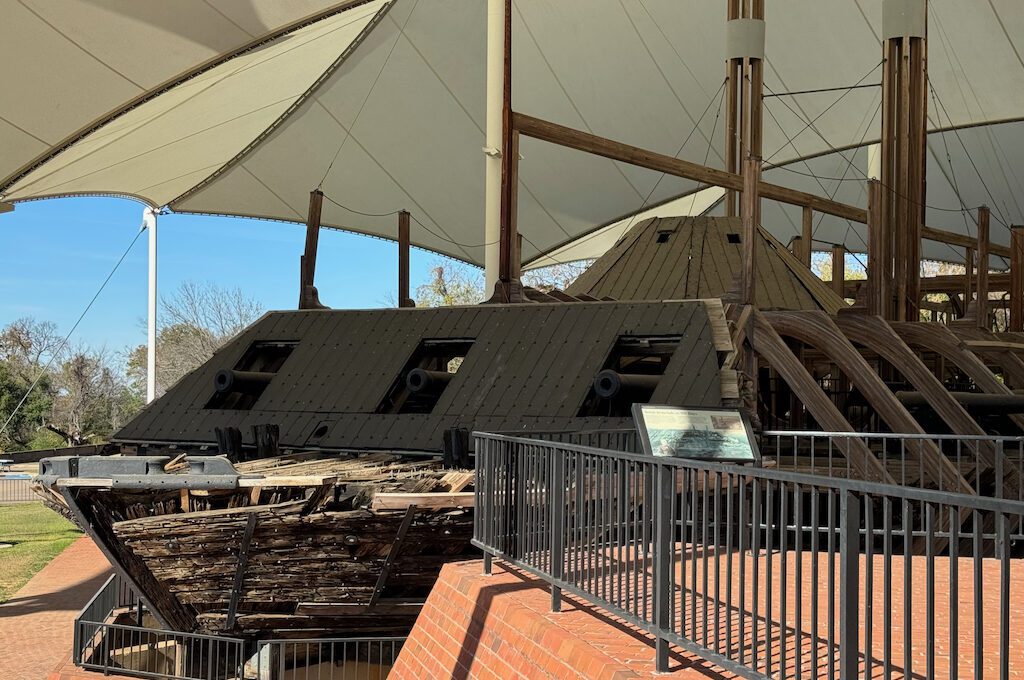
How to visit the USS Cairo
For those eager to explore the USS Cairo gunboat and museum, the most straightforward approach involves taking the northwest entrance into Vicksburg National Military Park. This route, accessible via Fort Hill Drive onto Connecting Avenue, provides a convenient and direct path, ideal for those primarily interested in the USS Cairo.
Alternatively, if you’re inclined to experience the entire expanse of the park, as we did, entering at the main entrance of Vicksburg National Military Park is the way to go.
Embark on a scenic drive down Union Avenue, immersing yourself in the rich history showcased through various monuments and battlefields along the way. The USS Cairo then becomes a culmination of your journey.
This comprehensive route builds anticipation, enhancing the awe-inspiring moment when you finally encounter the gunboat. So, if time is on your side, I highly recommend immersing yourself in the full spectrum of historical wonders that Vicksburg National Military Park has to offer.
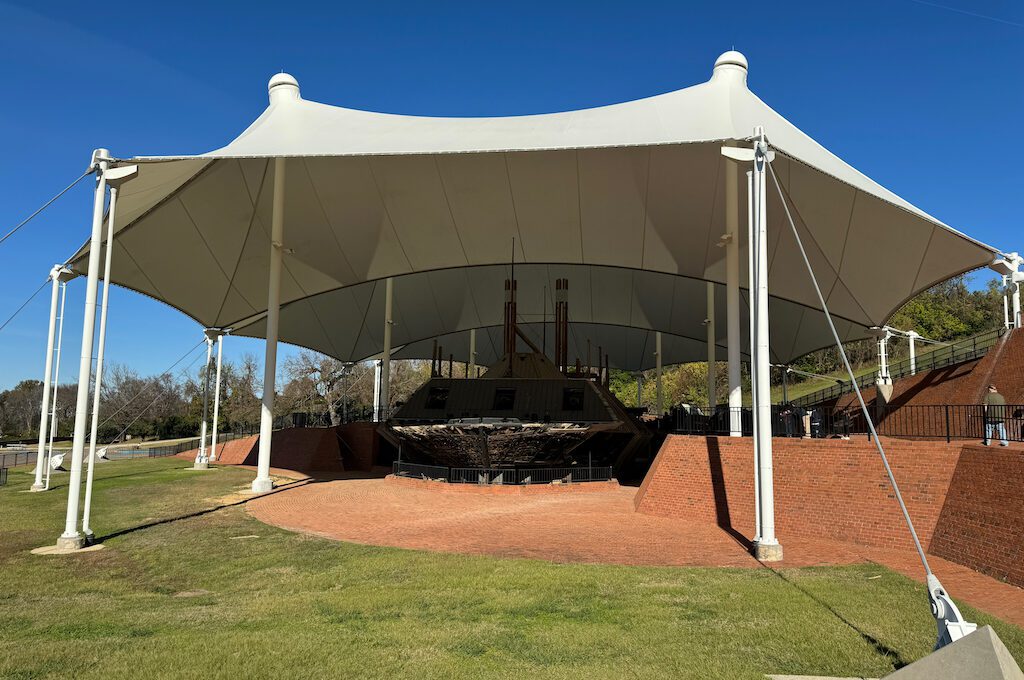
Our experience visiting the USS Cairo
Upon reaching the gunboat, you’ll see it rests beneath a sizable protective canopy, shielding it from the elements and ensuring its preservation.
Adjacent to this historical treasure, a generous parking lot beckons visitors to explore this area, including the nearby national cemetery.
While the museum on-site adds an extra layer of insight, unfortunately, during our visit, it was regrettably closed.
This proved to be a let down, given the prospect of delving into the array of captivating artifacts unearthed during the ship’s retrieval. But it just means we’ll have to return and it’s nice you can visit the ship even if the museum is closed.
For those curious about the museum’s offerings, a glimpse into its treasures is available by following this link to the National Park Service page.
The site of the USS Cairo is undeniably impressive, even though the passage of time has taken its toll, and the 175 foot vessel is far from perfectly preserved.
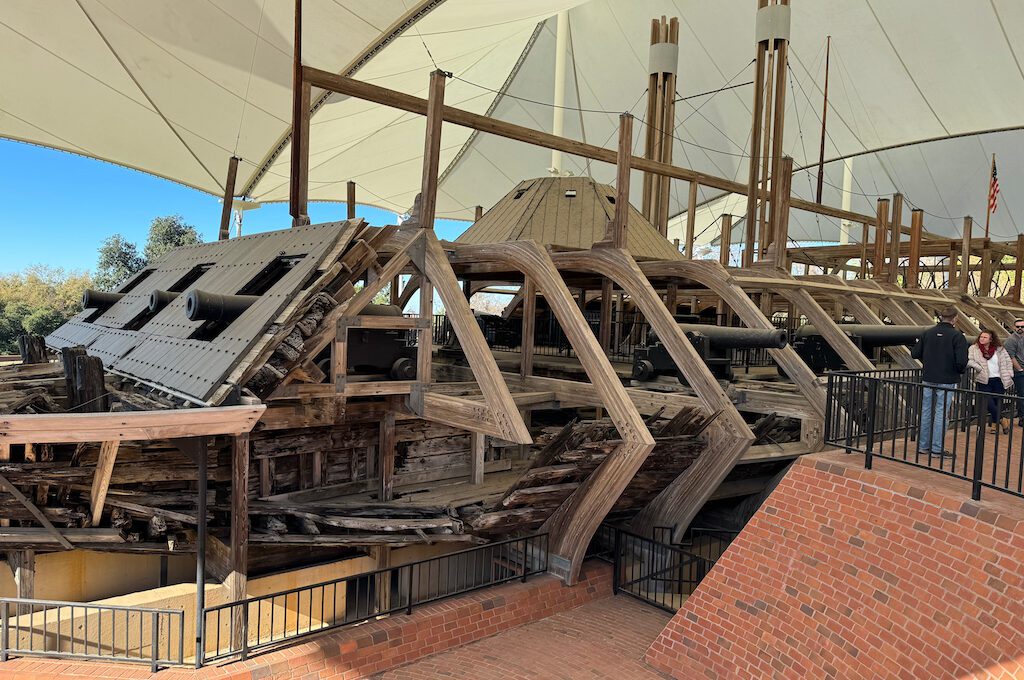
Notwithstanding the deterioration, certain components have endured remarkably well, such as the iron boards and cannons, offering visitors enough of a real connection to the ship’s original form and scale of engineering.
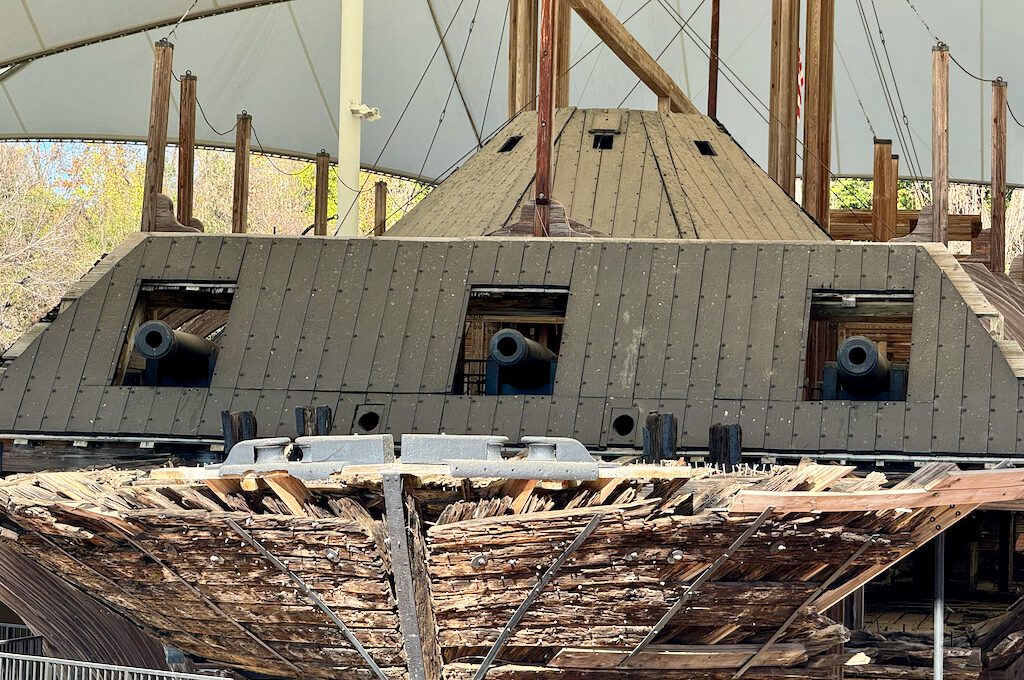
One of the most captivating aspects of the gunboat is the accessibility it affords.
The construction of a platform above and within the ship allows visitors to walk through its historic corridors. While the platform isn’t the original ship floor, it provides an immersive experience, offering glimpses into the internal framework that once upheld the vessel.
Sometimes, telling the difference between the ship’s original parts and newer additions can be a bit tricky. The internal frame, essential for keeping the ship together, shares space with added platforms and beams for support. While you can spot these additions, a slight change in the color of the wood could make things clearer.
Digging into the inner workings of the USS Cairo is a real adventure, giving you a peek at its engines, cannons, and all those tough nuts and bolts that held it together.
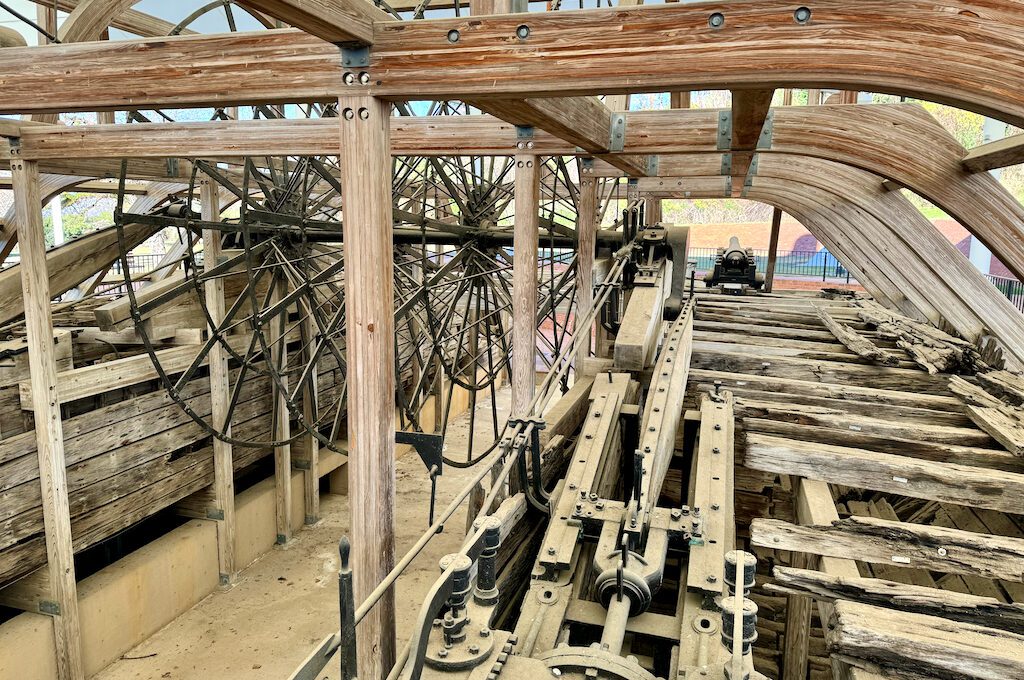
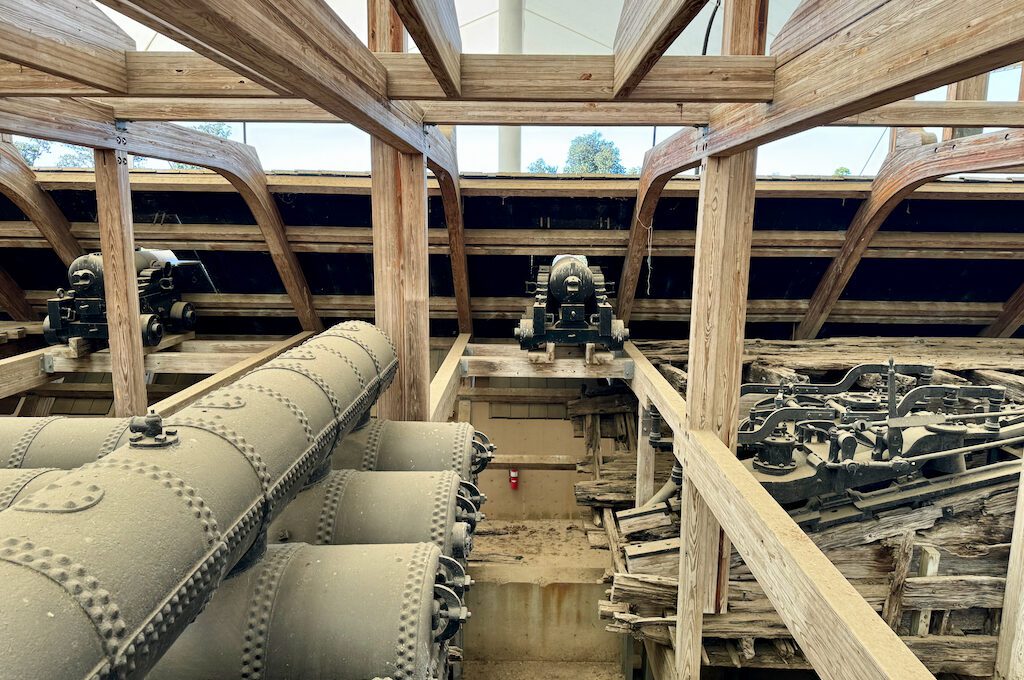
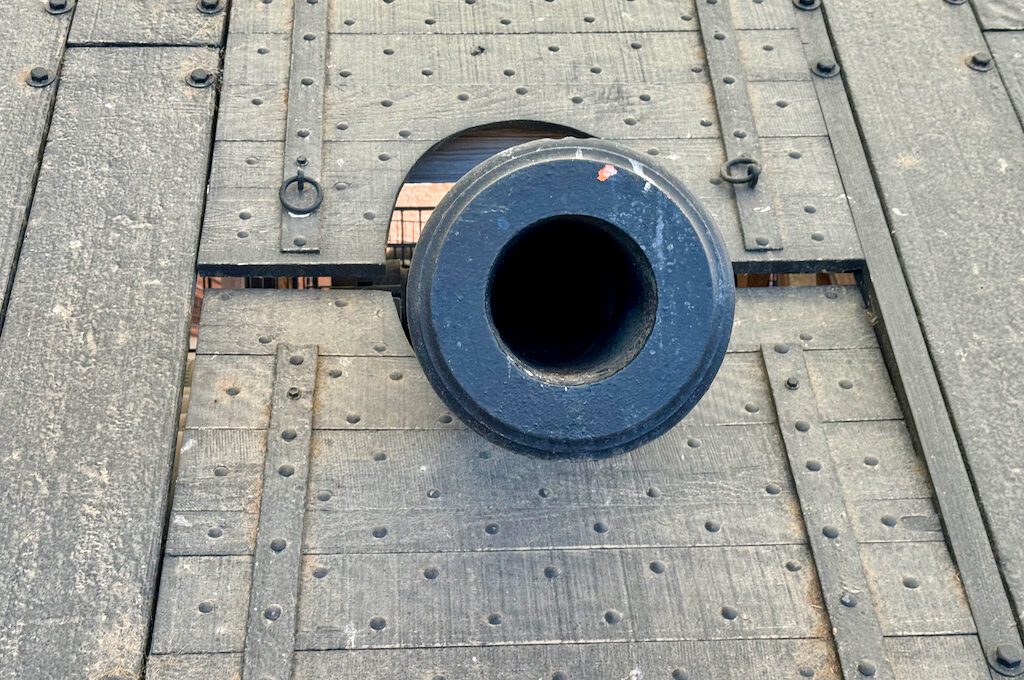
One standout is checking out the capstan—a heavy-duty winch that the crew relied on for all sorts of jobs, like dragging hefty lines, shifting guns around the deck, and reeling in the anchor.
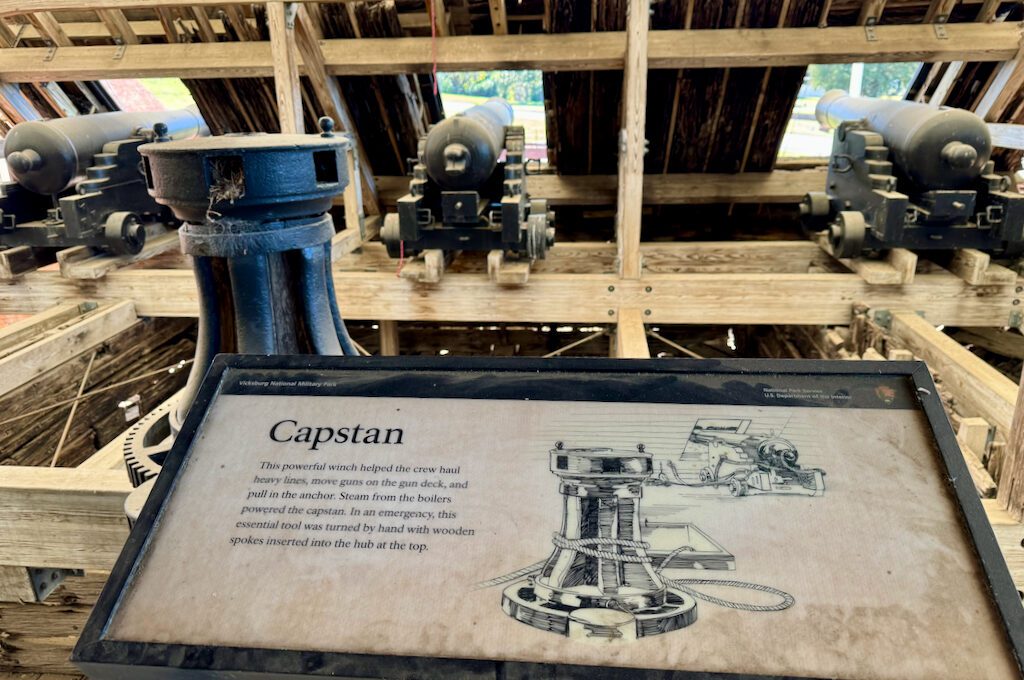
Our peaceful visit got a bit lively when a big tour group showed up, all set for a guided tour. We decided to hang back and listen in, picking up some valuable tidbits about the ship’s history.
If you’re flying solo, there are info panels all over the place. Adding in a bit of your own research can give you the full lowdown on why the USS Cairo is such a big deal.
One intriguing detail is the armor plating on the ship, featuring interlocking iron plates predominantly on its sides. Examining these plates from the inside of the ship reveals the interlocking mechanism. I thought it was very interesting that some of the iron used was repurposed from an iron railroad.
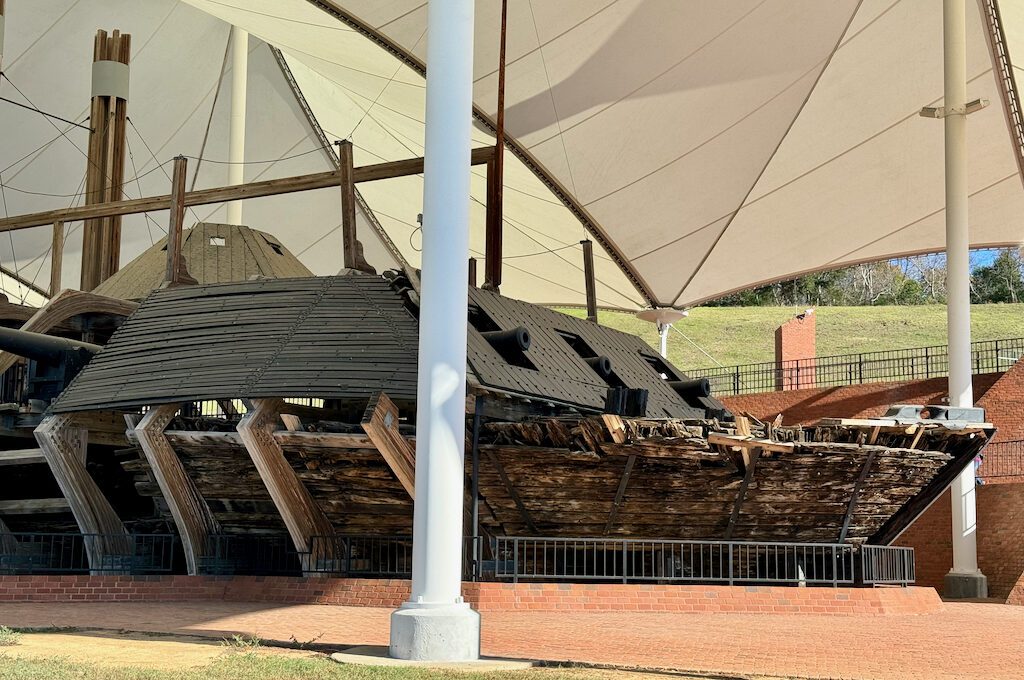
The main iron plates, measuring about two and a half inches in thickness, were backed by white oak planks, ranging from twelve to 25 inches thick. This design aimed to mitigate damage caused by cannonball impacts, with the wooden backing helping prevent the iron plates from shattering upon impact.
These ironclad ships, exemplified by the USS Cairo, were equipped with an impressive arsenal of 13 hefty cannons, each requiring a team of six men for positioning and firing. You can imagine the bustling activity inside these steamy vessels, as they patrolled the rivers north of Vicksburg, often in demanding conditions.
After delving into the ship’s interior, a leisurely stroll around its entirety allows for a full appreciation of its unique design and historical significance.
Witnessing this distinctive type of vessel in person — a sight previously confined to history books for me — was truly captivating.
Final word
My overall experience at this museum was quite enjoyable. While I regretted the closure of the actual museum, anticipating the intriguing artifacts it holds, it merely provides me with an incentive to return for another visit.
Even on days when the museum is closed, I firmly believe that witnessing the USS Cairo is well worth the visit. The unique sight of this preserved ironclad ship is bound to leave a lasting impression, offering a distinct encounter that is both fascinating and educational. I wholeheartedly recommend planning a visit, confident that the experience will be rewarding and leave you with a deeper understanding of this remarkable piece of history.
Daniel Gillaspia is the Founder of UponArriving.com and the credit card app, WalletFlo. He is a former attorney turned travel expert covering destinations along with TSA, airline, and hotel policies. Since 2014, his content has been featured in publications such as National Geographic, Smithsonian Magazine, and CNBC. Read my bio.

